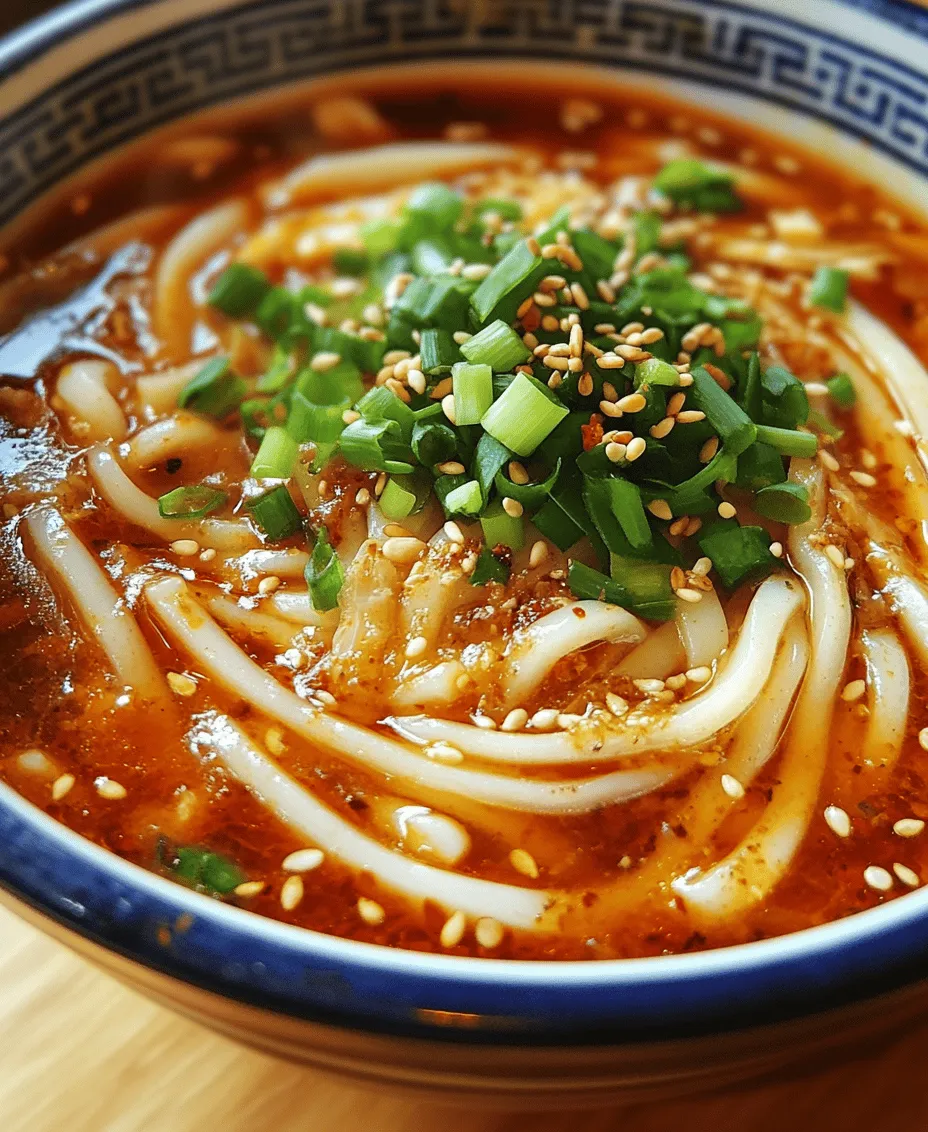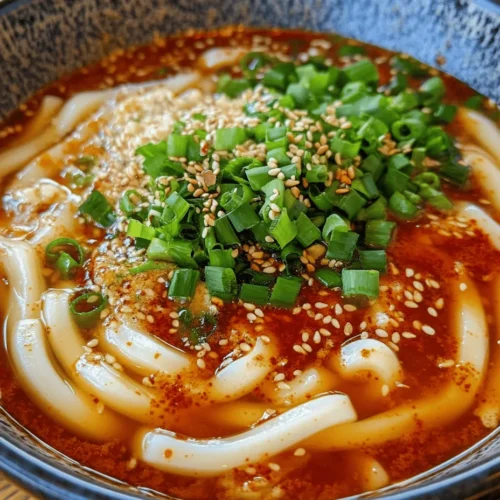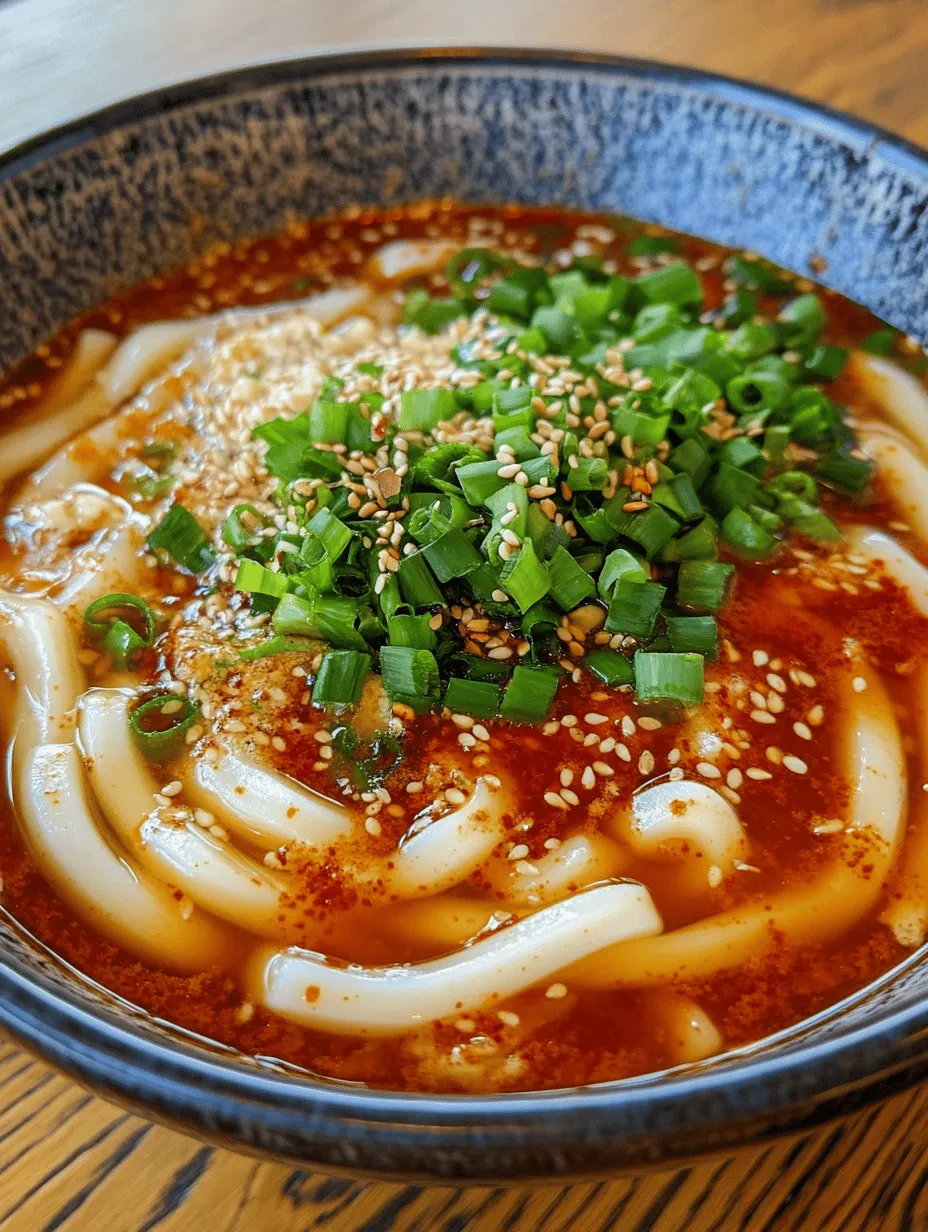Introduction
Udon noodles have carved a niche for themselves in the vast realm of Asian cuisine. These thick, chewy noodles are a staple in Japanese cooking, known for their versatility and heartiness. Whether served in a hot broth, tossed in a stir-fry, or enjoyed cold with a dipping sauce, udon noodles have captured the hearts of food lovers around the globe. Their neutral flavor allows them to absorb the essence of accompanying ingredients, making them a canvas for a myriad of flavors.
One flavor profile that beautifully complements udon noodles is the spicy, aromatic allure of chili oil. This oil, infused with the heat of dried chilies and the depth of other flavor-enhancing ingredients, transforms a simple bowl of noodles into a tantalizing dish. The warmth of chili oil not only brings heat but also a complex taste that elevates udon dishes to new heights.
In this article, we aim to provide a simple yet delicious recipe for Spicy Quick Chili Oil Udon Noodles that can be prepared in under 10 minutes. Perfect for busy weeknights or when you crave something comforting yet exciting, this recipe is a must-try for anyone looking to enjoy a burst of flavor without spending hours in the kitchen.
Understanding Udon Noodles
Udon noodles are traditionally made from wheat flour, water, and salt, resulting in a thick and chewy texture that is both satisfying and filling. These noodles date back to the Heian period in Japan and have since evolved into a beloved staple in various dishes across the country. Their history reflects the adaptability and cultural significance of noodles in Japanese cuisine.
Nutritionally, udon noodles offer several benefits. They are a good source of carbohydrates, providing the energy necessary for daily activities. Depending on the variety, udon noodles can also contain protein and fiber, particularly if made from whole grain flour. The fiber content aids in digestion, making them a wholesome choice when looking for a filling meal.
When purchasing udon noodles, you will find various options available in the market. Fresh udon noodles, often found in the refrigerated section, are soft and ready to cook, requiring minimal preparation time. Frozen udon noodles, while slightly less convenient, maintain their texture and flavor well after being thawed. Dried udon noodles, on the other hand, offer a longer shelf life and can be stored for extended periods, making them a pantry staple for many home cooks.
Exploring Chili Oil
Chili oil is a flavorful condiment made by infusing oil with dried chili peppers and other ingredients such as garlic, ginger, or Sichuan peppercorns. This oil is not only popular in Chinese cuisine but has also found its way into various Asian dishes, adding a kick of heat and depth of flavor that is hard to resist.
The history of chili oil dates back centuries, with its roots in Chinese cooking. Originally developed as a means of preserving chilies, it has evolved into a beloved ingredient that enhances countless dishes. Whether drizzled over dumplings, used as a dipping sauce, or incorporated into stir-fries, chili oil adds a bold touch to any meal.
In addition to its flavor, chili oil offers several health benefits. The capsaicin found in chili peppers is known for its metabolism-boosting properties, potentially aiding in weight management. Chili oil may also have anti-inflammatory effects, contributing to overall health when consumed in moderation.
When it comes to chili oil, you have the option to purchase store-bought varieties or make your own at home. Store-bought chili oil is convenient and readily available, but it can vary significantly in flavor and heat level. Homemade chili oil allows you to control the ingredients, ensuring a personalized touch that fits your taste preferences. To make your own, simply heat oil and infuse it with your choice of dried chilies and aromatics until the desired flavor is achieved.
Ingredients Breakdown
Creating the perfect Spicy Quick Chili Oil Udon Noodles requires careful consideration of the ingredients. Here’s a detailed look at each component of the recipe:
Udon Noodles
The star of the dish, udon noodles, come in various forms. Fresh udon noodles are soft and chewy, perfect for a quick cook time. Frozen udon noodles offer convenience without sacrificing texture, while dried udon noodles can be a pantry staple, requiring a longer cooking time. Regardless of the type you choose, udon noodles serve as a hearty base for the spicy chili oil.
Chili Oil
For this recipe, you can either use store-bought chili oil or create your own blend. When selecting store-bought chili oil, consider the heat level and flavor profile. Some brands may include additional spices or aromatics that can enhance your dish or may be too overpowering. Homemade chili oil can be customized by choosing the type of chili peppers you prefer, allowing for a unique flavor experience.
Soy Sauce
Soy sauce is an essential ingredient that adds depth and umami to the dish. There are different types of soy sauce available, including light, dark, and tamari. Light soy sauce is typically saltier and less viscous, while dark soy sauce adds sweetness and is thicker. Tamari, a gluten-free option, provides a rich flavor without the use of wheat. The type of soy sauce you choose will impact the overall taste of your udon noodles.
Sesame Oil
Sesame oil is a fragrant oil that enhances the nutty flavor of the dish. It is often used in Asian cooking for its distinct aroma and taste. In addition to its culinary uses, sesame oil is rich in healthy fats and contains antioxidants, which contribute to its health benefits.
Garlic and Ginger
Garlic and ginger are aromatic ingredients that add a fragrant kick to the dish. Garlic is known for its immune-boosting properties, while ginger can aid in digestion and has anti-inflammatory effects. Together, they create a flavor base that complements the heat of the chili oil.
Green Onions and Sesame Seeds
As garnishes, green onions and sesame seeds not only enhance the visual appeal of the dish but also contribute additional flavor and texture. Green onions provide a fresh, crisp element, while sesame seeds add a nutty crunch. Both ingredients are also packed with nutrients, making them a healthy addition to your meal.
Optional Proteins and Vegetables
To further customize your Spicy Quick Chili Oil Udon Noodles, consider adding proteins or vegetables. Options such as tofu, chicken, or shrimp can elevate the dish and make it more filling. Vegetables like bok choy, bell peppers, or snap peas can add color, texture, and additional vitamins. Feel free to mix and match your favorites for a personalized touch.
Step-by-Step Cooking Instructions
Now that we have an understanding of the ingredients, let’s delve into the cooking process. The following steps will guide you through preparing your very own Spicy Quick Chili Oil Udon Noodles:
1. Cook the Udon Noodles: Begin by boiling a pot of water. Once boiling, add the udon noodles and cook according to the package instructions. Fresh udon noodles typically take about 2-3 minutes, while dried versions may require 5-7 minutes. Once cooked, drain the noodles and rinse them under cold water to stop the cooking process.
2. Prepare the Chili Oil: If using store-bought chili oil, measure out the desired amount for the recipe. For homemade chili oil, heat a neutral oil (such as vegetable or canola oil) in a saucepan over medium heat. Add dried chili flakes and any additional aromatics such as garlic and ginger, stirring until fragrant.
3. Combine Ingredients: In a large mixing bowl, combine the cooked udon noodles, chili oil, soy sauce, and sesame oil. Toss well to coat the noodles evenly in the sauce.
4. Add Aromatics: Incorporate minced garlic and ginger into the noodle mixture, ensuring they are evenly distributed. This step will enhance the flavor profile, bringing together the heat from the chili oil and the savory notes from the soy sauce.
5. Garnish and Serve: Once the noodles are thoroughly mixed, transfer them to serving bowls. Top with sliced green onions, a sprinkle of sesame seeds, and any optional proteins or vegetables you desire. Serve immediately and enjoy the burst of flavors!
This quick and spicy udon noodle dish is perfect for those who appreciate bold flavors and easy preparation. With the right ingredients and a few simple steps, you can bring the taste of Asian cuisine to your dining table in no time. Stay tuned for the next sections, where we will delve deeper into tips for achieving the best results and address common questions about the dish.

Cooking the Udon Noodles
Cooking udon noodles is straightforward, but a few key practices can elevate your dish to restaurant-quality. First, it’s essential to start with a large pot of water. The ratio of water to noodles should be generous, as this allows for even cooking and prevents the noodles from becoming sticky.
Importance of Salting the Water
Salting the water is a crucial step that many home cooks overlook. Adding a generous amount of salt (about 1 tablespoon for every 4 cups of water) not only enhances the flavor of the noodles but also mimics the natural flavors found in high-quality udon. The salt helps to create a tastier foundation for the dish, ensuring that every bite of the noodles is infused with flavor.
Tips for Achieving the Perfect Texture
To achieve the perfect texture for udon noodles, it’s important to follow the cooking time specified on the package. Fresh udon noodles typically take about 3-5 minutes to cook, while dried noodles might need 8-10 minutes. A best practice is to taste the noodles a minute or two before the recommended time to check for doneness. The goal is to have them tender yet slightly chewy, a texture known as “al dente.” Once they are cooked to your liking, promptly drain them in a colander and rinse them under cold water to stop the cooking process. This step also helps remove any residual starch, keeping the noodles from clumping together.
Preparing the Sauce
The sauce is where the magic happens, blending flavors to create a deliciously spicy, savory coating for your udon noodles. It typically consists of chili oil, soy sauce, and a few aromatics that enhance the overall taste.
Techniques for Mixing Flavors Effectively
Start by heating your chili oil in a small saucepan over medium heat. This allows the flavors to bloom, making the oil more aromatic. Once heated, add minced garlic and ginger, sautéing them for just a minute until fragrant. Be careful not to burn these aromatics, as burnt garlic can impart a bitter taste.
Next, remove the pan from heat and mix in soy sauce, sesame oil, and a splash of rice vinegar for acidity. This combination balances the heat from the chili oil with umami from the soy sauce and a hint of acidity from the vinegar. Adjust the quantities to suit your taste preferences; if you prefer a milder sauce, start with less chili oil and gradually increase it to your liking.
The Role of Garlic and Ginger in Enhancing the Dish
Garlic and ginger serve as the backbone of your sauce, offering depth and warmth. Garlic brings a savory punch, while ginger adds a subtle warmth and brightness. Together, they elevate the overall flavor profile of the udon noodles, making the dish more complex.
Tossing the Noodles
Once your noodles are cooked and your sauce is ready, it’s time to bring everything together.
Best Practices for Coating Noodles Evenly
To ensure that the noodles are evenly coated with the sauce, it’s best to use a large mixing bowl. Add the drained noodles to the bowl and pour the sauce over them while they’re still warm. This warmth helps the noodles absorb the flavors more effectively. Toss the noodles gently with your hands or a large spoon until they are well coated.
The Importance of Using the Right Utensils
When it comes to tossing noodles, using the right utensils can make a significant difference. While some prefer using chopsticks for that authentic touch, tongs are excellent for evenly distributing the sauce without breaking the noodles. If you’re a novice with chopsticks, don’t hesitate to use a fork or tongs to ensure that all the noodles get the attention they deserve.
Adding Toppings
To elevate your spicy quick chili oil udon noodles, consider adding a variety of toppings that enhance both nutrition and taste.
Suggestions for Proteins and Vegetables
Proteins such as grilled chicken, shrimp, or tofu are excellent additions, providing a heartiness that complements the noodles beautifully. For a vegetarian option, marinated tofu or edamame can add protein without compromising the dish’s integrity.
In terms of vegetables, thinly sliced bell peppers, bok choy, or scallions introduce color and crunch to the dish. Mushrooms, such as shiitake or enoki, lend an earthy flavor that pairs well with the spiciness of the dish.
How to Incorporate These Additions Without Compromising the Dish’s Integrity
When adding toppings, it’s best to keep the proportions balanced. For instance, if you’re using a protein, aim for about 3-4 ounces per serving. As for vegetables, a handful of mixed veggies can add a fresh touch without overwhelming the dish. To ensure they blend seamlessly, sauté them lightly before incorporating them into the noodles. This way, they are tender but still retain some crunch, enhancing the overall texture of your meal.
Serving the Dish
Presentation plays a vital role in the overall dining experience.
Presentation Tips for an Appealing Plate
To create an appealing plate, use a white bowl or plate to contrast the vibrant colors of the noodles and toppings. Twirl the noodles using chopsticks or a fork to create a visually appealing mound in the center of the dish. Finish with an artistic drizzle of extra chili oil on top and a sprinkle of sesame seeds or chopped scallions for garnish. A wedge of lime or lemon on the side can add a pop of color and a fresh element that diners can squeeze over their noodles.
The Importance of Serving Temperature
Serving temperature is essential in enjoying the flavors of your spicy quick chili oil udon noodles. Ideally, serve the dish hot, as this enhances the aromatic qualities of the ingredients. If you are preparing the dish ahead of time, store the noodles and sauce separately in the refrigerator and reheat them gently in a pan before serving.
Flavor Variations and Customizations
The beauty of the spicy quick chili oil udon noodles lies in their versatility. You can easily adapt the recipe to suit your taste preferences or seasonal availability of ingredients.
Seasonal Variations
Consider incorporating seasonal vegetables to add freshness and variety to your dish. In the spring, asparagus and snap peas are delightful options, while summer may bring zucchini and sweet corn. During autumn, roasted pumpkin or butternut squash can lend a subtle sweetness that balances the heat of the chili oil. In winter, hearty greens like kale or Brussels sprouts can add a robust texture.
Heat Levels
Adjusting the heat level is also a fun way to make the dish your own. If you enjoy a milder flavor, start with just a teaspoon of chili oil and gradually increase it until you find your preferred level of spiciness. Alternatively, if you’re a heat enthusiast, adding fresh chopped chili or a dash of sriracha can take the heat to another level.
Alternative Proteins for Dietary Restrictions
For those with dietary restrictions, this recipe can easily be adapted. For a vegan version, substitute traditional proteins with plant-based options like tempeh or chickpeas. If gluten-free, ensure you choose gluten-free udon noodles or substitute them with rice noodles for a similar texture.
Suggestions for Pairing with Sides or Beverages
To enhance your meal, consider pairing your spicy quick chili oil udon noodles with a refreshing side salad or steamed dumplings. A light cucumber salad drizzled with sesame oil can complement the richness of the noodles beautifully. For beverages, a chilled green tea or a light beer can balance the meal’s spiciness.
Conclusion
The spicy quick chili oil udon noodles recipe is a celebration of simplicity and versatility. With easy-to-find ingredients and a quick preparation time, it’s an ideal choice for busy weeknights or casual gatherings. The ability to customize the dish according to personal tastes and seasonal vegetables makes it a favorite among home cooks.
Encouragement to experiment is key; don’t hesitate to play with different sauces, toppings, and spice levels. The joy of cooking is often found in the creative process, and this recipe serves as a perfect canvas for your culinary expression. So go ahead, indulge in this delightful dish, and make it your own!



